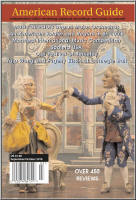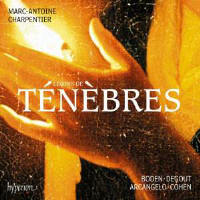Texte paru dans: / Appeared in: |
|
|
Outil de traduction ~ (Très approximatif) |
|
|
Reviewer: William
J. Gatens Marc-Antoine Charpentier (1643-1704) achieved a remarkable synthesis of French and Italian musical styles in his prolific output of sacred composition. The Italian influence stemmed from his studies in Rome with Giacomo Carissimi in the 1660s. This may have been a disadvantage when he attempted gain an appointment at the court of Louis XIV and at the opera, then ruled with a heavy hand by Lully, himself a native Italian. On the other hand, the Italian element would have been welcomed by the Jesuits, who maintained a prominent presence in Paris at that time. Soon after his return to France, Charpentier accepted an appointment as composer in residence for the private chapel of the Duchess of Guise, who maintained a small but excellent musical establishment. In this and other appointments later in his life, he developed an intimate style of sacred music that has the flavor of chamber composition. In the process he left us what Jonathan Cohen describes in the notes as “the largest body of 17th-Century French music by one composer, consisting almost entirely of autograph manuscripts”. His work list occupies 18 pages in New Grove.
The recording contains several fine examples of Charpentier’s sacred works. The greater part of the program consists of three Tenebrae Lessons for solo voice with different combinations of obbligato instruments and continuo. Tenebrae is originally a special form of the office of Matins in Holy Week, observed mainly in monastic communities. The office is sung during the night in three Nocturnes, concluding at daybreak with the office of Lauds. Each Nocturne includes three lessons from Holy Scripture or the writings of the Fathers and three responsories.
By Charpentier’s day it was common for Tenebrae to be observed as a public liturgy and moved forward to the late afternoon or early evening, with at least some of the lessons and responsories set to concerted music. Charpentier’s catalog includes some 53 compositions for this office. The three lessons here are for the First Nocturne of Maundy Thursday and would have been sung on the preceding Wednesday. The texts come from the Lamentations of Jeremiah and include the Hebrew initials and the refrain “Jerusalem, Jerusalem, convertere ad Dominum Deum tuum” (turn to the Lord your God). The first lesson is for baritone with violin, violas, recorders, and continuo. The second is for tenor with viola da gamba and continuo. The gamba part is soloistic when the singing voice is silent, but becomes a continuo bass to support the singer. The third lesson is for baritone with pairs of violins, transverse flutes, and continuo. Charpentier sets te texts in an eloquent declamatory style with characteristics of recitative and arioso. One can only marvel at the melodic and harmonic freshness of these settings and their dignified solemnity. The program opens with the Litany of Loreto (H 83) composed for the Guise Chapel. It is one of nine settings of this text by Charpentier. All the others were for Jesuit institutions. It is for six voices with two high strings and continuo. The composer contrasts groups of higher and lower voices with the full ensemble. Again one must marvel at his freshness of invention in a highly repetitive text that might induce lesser composers to spin their wheels. Of his ten settings of the Magnificat, the one recorded here (H 73) stands out. It is scored for three male voices—haute-contre, tenor, and bass—with two treble instruments and continuo. It is an unusual combination, but Charpentier appears to have been fond of it, as it occurs again and again in his works. Perhaps even more remarkable is the fact that this Magnificat unfolds gainst a descending four-note ground bass. The composer’s ingenuity in projecting the solo and obbligato parts against this ground puts him in the company of such composers as Monteverdi, Purcell, and Bach as a master of the genre.
The remaining work recorded here is the Overture for the Consecration of a Bishop, one of several of the composer’s purely instrumental pieces intended for an ecclesiastical ceremony. Jonathan Cohen directs his period-instrument ensemble Arcangelo in readings of great elegance and sensitivity. These are performances of the highest order. My only mild complaint is that baritone Stephane Degout is somewhat overbalan-ced in the more fully scored passages of the First Tenebrae Lesson. That is not the case in the Third Lesson. Samuel Boden’s light and clear voice floats serenely in the more lightly scored Second Lesson. He has a special interest in the French baroque haute-contre repertory. This is a type of high tenor singing in full voice in what we would regard as the alto range, in contrast with most countertenors, who are falsettists. The booklet gives full texts and translations as well as an informative essay by Adrian Powney.
A few years ago I reviewed a
very fine recording of music by Charpentier for an ensemble of three male
voices. It includes the Magnificat recorded here and seven other works for
that combination (Ligia 202233; S/O 2012). Readers who find this new
recording attractive may wish to acquire that one as well. | |
|
|
|
|
Cliquez l'un ou l'autre
bouton pour découvrir bien d'autres critiques de CD |
|




